Home Tags Posts tagged with "airasia plane crash"
airasia plane crash
AirAsia QZ8501 fuselage recovery operation has been suspended, the Indonesian military has said.
The plane crashed into the Java Sea in December 2014.
Search teams failed to retrieve the fuselage after three days of attempts using a lifting bag.
Officials initially thought bodies were inside, but now say recovering the wreckage is not a priority as they believe no victims remain.
So far only 70 bodies of the 162 people who were on board have been found.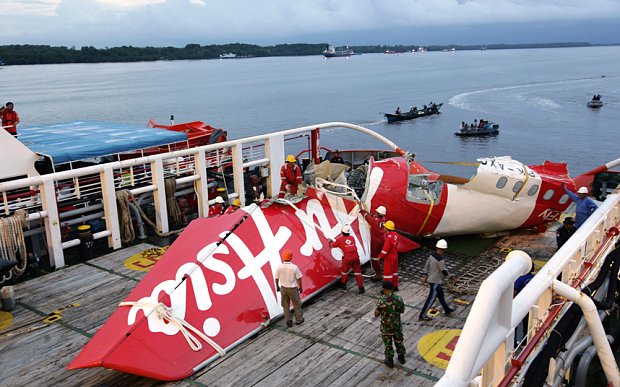
The recovery operation has been hampered by stormy weather.
It comes after a previous attempt to raise the plane on January 24 failed when the fuselage began to break into pieces.
AirAsia flight QZ8501 was flying from Surabaya in Indonesia to Singapore when it plummeted into the sea on 28 December.
A preliminary report on the crash is expected to be filed this week, although the full investigation will take months.
On January 23 divers entered the main section of the fuselage, which is at a depth of 30m.
The plane’s cockpit voice recorder and flight data recorder were found earlier this month.
Information retrieved from the recorders showed that the jet had climbed too fast, causing it to stall, according to Indonesia’s Transport Minister Ignasius Jonan.
[youtube 9nG9qnIGXbw 650]
According to Indonesia’s transport minister Ignasius Jonan, the AirAsia flight that crashed in the Java Sea, killing 162 people, climbed too fast before stalling.
Ignasius Jonan told a parliamentary hearing in Jakarta that flight QZ8501 had ascended at a speed of 6,000ft per minute.
No passenger or fighter jet would attempt to climb so fast, he said.
There were no survivors when the plane crashed on December 28, en route from Surabaya to Singapore.
The Airbus A320-200 is thought to have encountered difficulties from an approaching storm.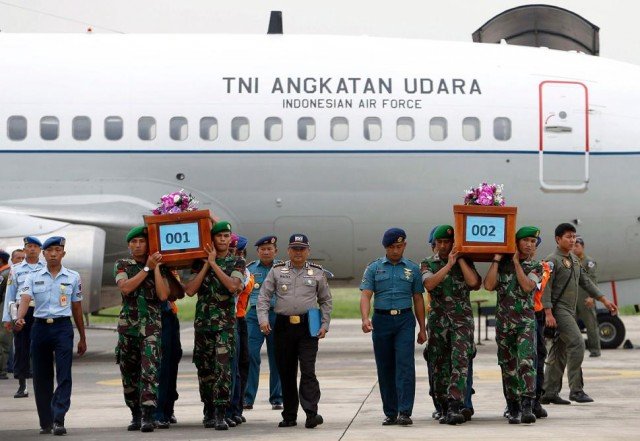
Fewer than one-third of the bodies have been retrieved from the crash area, where debris was scattered across the sea.
Citing radar data, Ignasius Jonan said: “The plane, during the last minutes, went up faster than normal speed… then it stalled.”
“I think it is rare even for a fighter jet to be able to climb 6,000ft per minute,” he told a House of Representatives commission.
“The average speed of a commercial aircraft is probably between 1,000 and 2,000ft per minute because the aircraft is not designed to soar so fast.”
A source familiar with the investigation’s initial findings told Reuters last month that radar data appeared to show flight QZ8501 had made an “unbelievably” steep climb before it crashed, possibly pushing the jet beyond its limits.
Last week, the cockpit voice recorder and flight data recorder were found.
The fuselage of the plane, believed to hold most of the remaining bodies, has also been located and search teams are now working out how to retrieve it.
Investigators have already said it is unlikely the crash was caused by terrorism.
Ignasius Jonan also proposed changes to improve aviation safety standards, Reuters reports.
His ministry was recommending pay rises for maintenance crews and safety inspection officials, he was quoted as saying.
Applications for route permits and air transport licenses would be moved online in February, he added.
The minister said a number of new rules regarding permits and safety, including health checks for flight crews and air traffic controllers, had already been implemented.
“It is a habit among airlines that they sometimes sell tickets before they have obtained a route permit,” he was quoted by Reuters as saying.
“Now route permits must be obtained four months before the flight and airlines will not be allowed to sell tickets before that.”
The jet took off from Surabaya at 05:35 local time on December 28.
Shortly before it vanished, nearly halfway into the two-hour flight, its pilot contacted air traffic control to request permission to climb to 38,000ft from 32,000ft to avoid big storm clouds – a common occurrence in the area.
However, heavy air traffic in the area meant he was not given permission to do so straight away.
When air traffic control tried to contact the plane again, there was no answer. The plane disappeared from radar screens shortly afterwards. It did not issue a distress signal.
A preliminary report on the crash is expected on January 28.
[youtube lPdxm8pP-Rc 650]
The crash of AirAsia QZ8501 was not likely due to terrorism, Indonesian investigators said in their first remarks since analyzing the cockpit voice recorder.
There were also indications that the plane encountered bad weather.
The AirAsia plane is thought to have gone down on December 28 when it encountered difficulties from an approaching storm.
All 162 people onboard the flight from Surabaya to Singapore perished.
Two more bodies were recovered on January 19, bringing the total found so far to 53.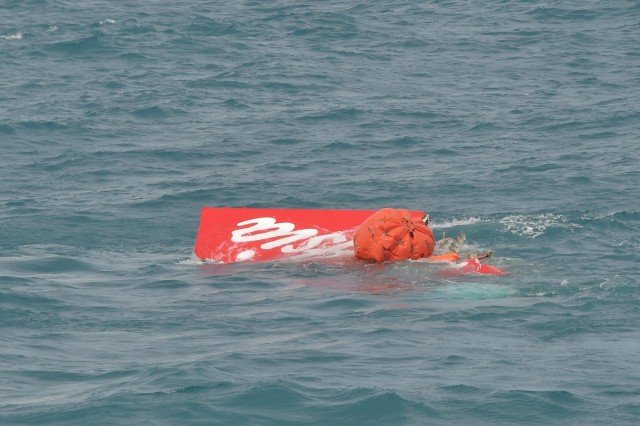
Investigators had listened to the entire two-hour recording, and found that there was no threatening voice on board.
The recording appeared to indicate that the pilot was too busy attempting to regain control of the aircraft to send a distress signal.
Some of the parameters retrieved from the flight data recorder seemed to indicate that the plane had encountered bad weather.
More analysis was needed from the rest of the 1,200 parameters to determine the exact weather conditions and the impact the weather had on the plane’s engines.
Investigators have only transcribed half of the cockpit voice recording and that would require more analysis as well.
Search teams managed to find the cockpit voice recorder and the flight data recorder last week.
The fuselage of the plane, believed to hold most of the bodies, has also been located and search teams are now working out how to retrieve it.
The authorities are expected to issue a preliminary report on the crash on January 28.
[youtube mxGd9rXO8iA 650]
The fuselage of the crashed AirAsia plane has been located and photographed in the Java Sea, say officials.
Singapore’s Defense Minister Ng Eng Hen posted pictures taken by a Singaporean search robot on his Facebook page.
Ng Eng Hen said the words painted on the side of the wreckage confirmed the plane was flight QZ8501.
AirAsia lost contact with the flight on December 28 as it was flying from Surabaya in Indonesia to Singapore with 162 people on board.
Dozens of bodies have been found but many of the passengers and crew are thought to still be inside the plane, which made finding the fuselage so important.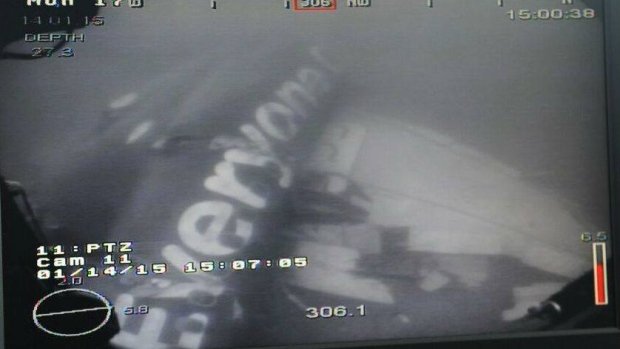
So far the plane’s two flight recorders and a tail section have been found and brought to shore. Investigators are analyzing the information in the “black box”, as the data recorders are known, to piece together the cause of the crash.
The pilot of the AirAsia flight had asked for a route change because of stormy weather before contact was lost, but it is not yet known for certain what brought down the plane.
“The MV Swift Rescue has located the fuselage of the AirAsia plane in the Java Sea,” Ng Eng Hen said on Facebook, adding that Singapore had informed the Indonesian search and rescue agency so that recovery operations could begin.
He said images taken by a remotely operated vehicle, which he posted as well, showed part of the wing and words on the fuselage that matched with those on the AirAsia flight.
The AirAsia slogan “Now everyone can fly” could be seen on the wreckage in the pictures.
The head of Indonesia’s search and rescue agency, Bambang Soelistyo, had said what they suspected was the fuselage had been spotted by search teams on Tuesday but that they were waiting for confirmation.
Bambang Soelistyo said it was not yet clear whether there were bodies inside, but that authorities hoped that was the case.
Earlier in the day when the wreckage was being investigated by divers, the official co-ordinating the search, SB Supriyadi, said raising the fuselage would be a tricky operation and authorities would have to determine the best course of action.
“If it is not too heavy, we may lift the whole piece and evacuate the victims,” said SB Supriyadi.
“If it’s too heavy, we may then swim into the fuselage and pull out the bodies one by one before lifting it.”
Since the plane disappeared a multi-national search has been under way involving aerial searches and more than 30 ships. However, strong currents, high waves and poor visibility have slowed down search and rescue efforts.
[youtube o2cjtwr-ubc 650]
Indonesian divers have retrieved the cockpit voice recorder from the crashed AirAsia flight QZ8501, say officials.
The retrieval comes a day after the first piece of the so-called black box, the flight data recorder, was also found and brought to shore.
AirAsia plane with 162 people on board disappeared between Surabaya in Indonesia and Singapore on December 28.
The two devices will help investigators understand more about what went wrong.
Forty-eight bodies have been recovered so far, but most of the victims are believed to still be inside the fuselage.
SB Supriyadi from Indonesia’s search and rescue agency said the fuselage had been located by divers about 0.9 miles from where the tail section was found last week.
He said there were no plans yet to go down and retrieve it.

Photo Reuters
The voice recorder was freed from underneath heavy wreckage of a wing from a depth of about 98 feet early on Tuesday, said Tonny Budiono, sea navigation director at the Transportation Ministry.
“This is good news for investigators to reveal the cause of the plane crash,” he said.
Santoso Sayogo, from the National Transportation Safety Committee, also confirmed the find to Reuters.
An unnamed official involved in the search told reporters the device was now on board Indonesia’s Banda Aceh warship, in the Java Sea.
The device – which records all conversations between the pilots – was being taken to Jakarta, where it will be analyzed by aviation experts.
The flight data recorder – holding information about the speed at which the plane was travelling, its altitude and other technical information – is already in Jakarta.
Flight recorders are designed to survive a crash and being submerged in water. They contain underwater locator beacons which emit so-called “pings” for at least 30 days.
These pings were detected by search vessels at the weekend but divers were prevented from going down to find them by strong currents and high waves.
[youtube NBYjGPVElC8 650]
The black box flight recorder of crashed AirAsia Flight QZ8501, say Indonesian officials.
They believe they have also located the cockpit voice recorder, the second part of the so-called black box, but divers have not yet managed to reach it.
AirAsia flight QZ8501 disappeared in bad weather on December 28 with 162 people on board.
The aircraft, which was flying from Surabaya in Indonesia to Singapore, is thought to be deep in the Java Sea.
Dozens of bodies have been recovered but most of the victims are believed to still be inside the fuselage, which has not been found.
Speaking in Jakarta, the head of Indonesia’s search and rescue agency Bambang Soelistyo told reporters: “I received information from the National Transport Safety Committee chief that at 07:11, we succeeded in bringing up part of the black box that we call the flight data recorder.”
He said the flight data recorder was found under the wreckage of a wing.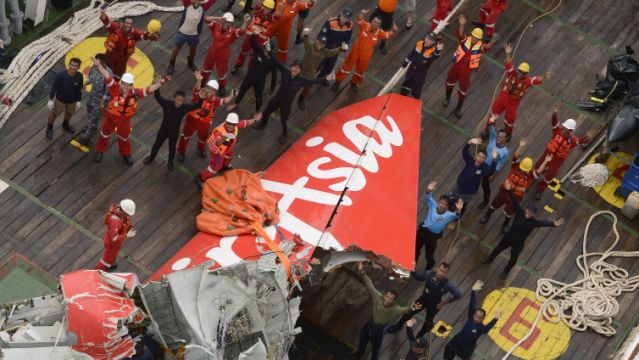
Hours later, other officials said the cockpit voice recorder had also been detected but divers had not yet managed to reach it.
The two recorders, usually housed inside the rear part of the plane, are designed to survive a crash and being submerged in water. They contain underwater locator beacons which emit so-called “pings” for at least 30 days.
Suyadi Bambang Supriyadi, operations co-ordinator for Indonesia’s search and rescue agency, said that based on initial analysis of the wreckage, the plane could have “exploded” upon landing on the water.
“The cabin was pressurized and before the pressure of the cabin could be adjusted, it went down – boom. That explosion was heard in the area,” he was quoted as saying by AFP news agency.
Over the weekend, three ships detected pings that were thought to be from the black box’s emergency locator transmitter. However, strong currents and high waves prevented the search operations.
The tail section of the Airbus A320-200 was brought to the surface, but the flight recorder was not inside it, as had been hoped.
On January 12, weather allowed for divers to retrieve the flight data recorder.
The international search for the fuselage and the remaining missing passengers and crew is continuing in the Java Sea.
Bambang Soelistyo said all ships now “will be deployed with the main task of searching for bodies that are still or suspected to still be trapped underwater”.
[youtube usGvKCC5flE 650]
The main fuselage of missing AirAsia flight QZ8501 may have been located in the Java Sea, Indonesian search teams say.
An object resembling the plane’s body was found in a sonar scan of the search area in the Java Sea, an official said.
Officials hope the “black box” flight recorders will be near the object – close to where the tail was found.
AirAsia flight QZ8501, carrying 162 people, was flying from Surabaya in Indonesia to Singapore when it vanished from radar in bad weather on December 28.
First Marshal S.B. Supriyadi, operations coordinator for Indonesia’s search and rescue agency, said the sonar scan had revealed an object on the sea floor that measured 33ft by 13ft by 8ft.
“They suspect it is the body of the plane. There is a big possibility that the black box is near the body of the plane,” he told Reuters news agency.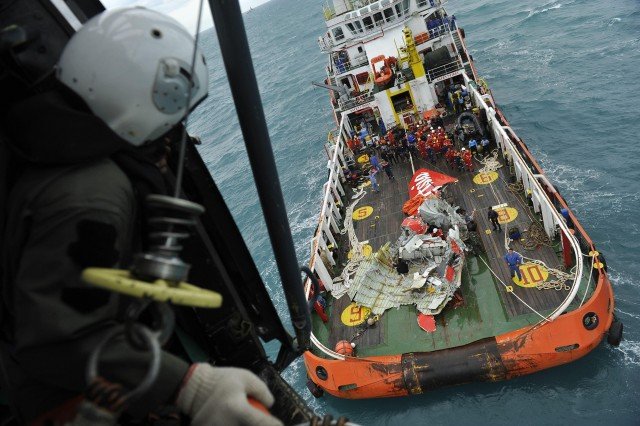
A team of divers had been sent to investigate, he added, but poor weather conditions have once again been hampering the search efforts.
“If it is the body of the plane then we will first evacuate the victims. Secondly we will search for the black box,” S.B. Supriyadi said.
Search teams have also been hearing pings, believed to be from the aircraft’s black boxes, near where the tail of the Airbus A320-200 aircraft tail was retrieved from on January 10.
Rescue workers have been pulling bodies and wreckage from the sea but progress has been slow. Forty-eight bodies have been retrieved so far.
The cause of the crash is unknown but the plane had encountered bad weather and asked for a flight path change before communication was lost.
The “black box” flight data recorders are usually housed inside the rear part of the plane.
They are designed to survive a crash and being submerged in water, and contain underwater locator beacons which emit the so-called “pings” for at least 30 days.
[youtube GcZiF09XsU0 650]
The tail of the AirAsia plane that crashed two weeks ago has been recovered from the seabed, the Indonesian navy has announced.
Divers used an inflatable device to pull the tail to the sea’s surface.
They are also searching for the plane’s “black box” flight recorders, which officials believe have been separated from the tail section.
AirAsia flight QZ8501 disappeared from radar in bad weather on December 28 with 162 people on board. It was flying from Surabaya in Indonesia to Singapore.
Forty-eight bodies have been retrieved so far. Search teams believe most of the remains may still be inside the fuselage of the plane, which has yet to be found.
On January 9, pings were detected in the Java Sea near where the tail was found. Officials said they could have come from the plane’s “black box” flight recorders.

Photo AP
The rear part of the Airbus A320-200 was spotted on January 7 by an unmanned underwater vehicle at a depth of about 100ft.
It was upside down and partially buried about 20 miles from the point of last contact with the plane, off the coast of Borneo, authorities said.
Search teams have been pulling bodies and wreckage from the sea but progress has been slow due to high waves and stormy weather.
The cause of the crash is unknown but the plane had encountered bad weather and asked for a flight path change before communication was lost.
The “black box” flight data recorders are usually housed inside the rear part of the plane.
They are designed to survive a crash and being submerged in water, and contain underwater locator beacons which emit the so-called “pings” for at least 30 days.
Finding them has been one of the top priorities for search teams as they provide crucial clues from the last moments of the flight before it came down.
[youtube Qxdzp4HAFgg 650]
Search teams have announced that “pings” have been detected in the Java Sea which could have come from the “black box” flight recorders of AirAsia flight QZ8501.
The pings were heard near where the plane’s tail was found. Officials say the black box could have been separated from the rear part of the plane.
Flight QZ8501 disappeared from radar on December 28 with 162 people on board.
No survivors have been found from the Airbus A320-200, which was flying from Surabaya in Indonesia to Singapore.
“We received an update from the field that the pinger locator already detected pings,” said Santoso Sayogo, an investigator at the National Transportation Safety Committee.
“We have our fingers crossed it is the black box. Divers need to confirm. Unfortunately it seems it’s off from the tail. But the divers need to confirm the position.”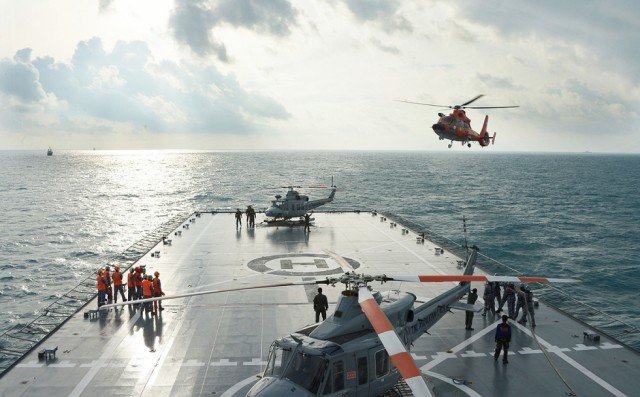
The “black box” flight data recorders are usually housed inside the rear part of the plane. They are designed to survive a crash and being submerged in water, and contain underwater locator beacons which emit the so-called “pings” for at least 30 days.
Finding them has been one of the top priorities for search teams as they provide crucial clues from the last moments of the flight before it came down.
The cause of the crash is unknown but the plane encountered bad weather and asked for a flight path change before communication was lost.
The rear part of the plane was spotted on January 7 by an unmanned underwater vehicle at a depth of about 30 meters.
Authorities said it was upside down and partially buried about 20 miles from the point of last contact with the plane, off the coast of Borneo.
The commander of the Indonesian armed forces, Gen. Moeldoko said on January 9 the tail appeared to be in broken condition.
Authorities have been pulling bodies and wreckage from the sea but progress has been slow due to high waves and stormy weather.
Forty-six bodies have been retrieved so far. Search teams believe most of the remains may still be inside the fuselage of the plane which has yet to be found.
[youtube He5Rl4yyKhc 650]
Indonesia’s search and rescue teams have found the tail of crashed AirAsia flight QZ8501 in the Java Sea, the head of the rescue agency has announced.
The tail houses the “black boxes” – the voice and flight data recorders – which could give investigators clues as to the cause of the crash.
AirAsia flight QZ8501 was en route from Surabaya, Indonesia, to Singapore on December 28 with 162 people on board when it disappeared from radar.
“We have found the tail that has been our main target today,” Bambang Soelistyo told reporters in the capital, Jakarta.
It was spotted by teams involving divers and unmanned underwater vehicles, he said. It is the first significant piece of wreckage from the crash to be identified.
Only 40 bodies have been recovered so far but the authorities believe many of the passengers may still be strapped inside the main body of the plane.
AirAsia chief executive Tony Fernandes tweeted: “We need to find all parts soon so we can find all our guests to ease the pain of our families. That still is our priority.”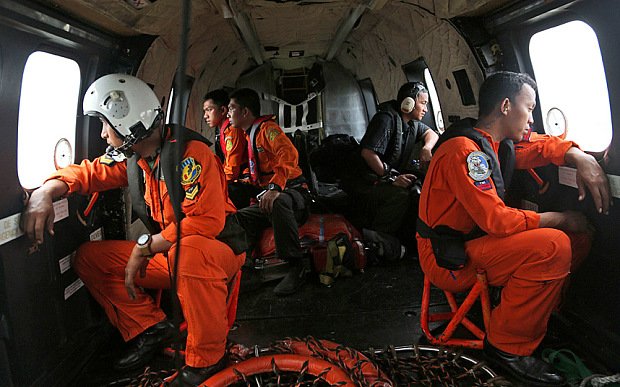
On January 6 the search area was expanded as search officials suspected that strong underwater currents could be pushing the debris away from the last point of contact with the plane.
A huge international operation with aerial searches and more than 30 ships involved has been repeatedly hampered by poor weather. Some wreckage, including seats and a door, was found floating on the sea.
At the weekend search officials said sonar had detected what they thought were five large parts of the plane but strong currents and rough seas would not allow divers to confirm they were from the AirAsia flight.
The cause of the crash is not known but the plane was flying through stormy weather at the time and had requested permission to change course.
Indonesian aviation officials have said that AirAsia did not have permission to fly the Surabaya-Singapore route on the day of the crash.
[youtube lguD3zXltk8 650]
Four more bodies have been recovered from the Java Sea as the hunt to find the main wreckage of AirAsia flight QZ8501 enters a second week.
Indonesia search and rescue chief Bambang Soelistyo said 34 bodies have now been found, as well as five large objects.
Bad weather has forced divers to suspend their bid to find the plane’s fuselage, where most of the bodies are believed to be trapped.
The plane, which was carrying 162 people, crashed on December 28.
It was en route from Surabaya in Indonesia to Singapore.
Bad weather is believed to be the biggest factor in the crash although the Airbus A320’s “black boxes”, or flight data recorders, have yet to be located.
Bambang Soelistyo said on January 4 that Singapore navy vessel RSS Persistence had recovered one body, while US navy ship USS Sampson had brought three more back to the Indonesian town of Pangkalan Bun.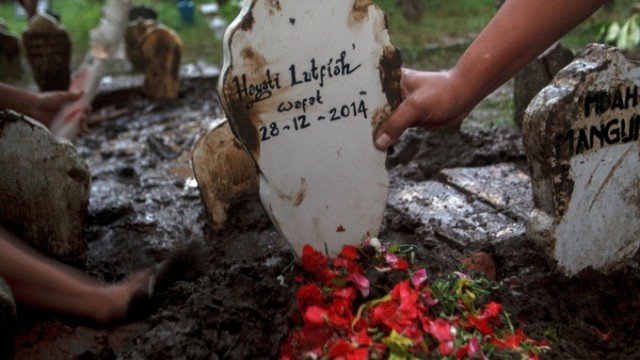
Nearly 30 ships are now involved in the search operation, as well as six planes and 14 helicopters.
There were hopes the weather would improve on Sunday, but conditions once again hampered efforts to find the plane’s main wreckage.
Search teams found four large objects thought to be debris from the plane on January 3, with the largest measuring 59ft.
A fifth object was located on the seabed on January 4, Bambang Soelistyo told reporters.
Dozens of divers from Indonesia and Russia have been deployed to the search area, which has been enlarged to allow for tides sweeping bodies and debris further afield.
They attempted to survey more of the seabed on Sunday but “visibility at the sea bottom was zero,” Bambang Soelistyo said.
Remotely operated cameras were being used to try to photograph the objects, but waves up to 16ft high and strong currents made their use difficult.
National Search and Rescue deputy chief Tatang Zainudin said: “We are racing with time and weather in running this mission.”
On January 3, Indonesian weather agency BMKG said initial analysis suggested icy conditions in the air had caused the engine to stall.
Officials have said the plane was travelling at 32,000ft when the pilot’s last communication was a request to climb to 38,000ft to avoid bad weather.
It has emerged that AirAsia did not have official permission to fly the Surabaya-Singapore route on the day of the crash, but was licensed on four other days of the week.
[youtube rGH8qVIv48M 650]
According to the Indonesian weather agency (BMKG), bad weather was the biggest factor in the crash of AirAsia flight QZ8501.
The BMKG agency said initial analysis suggested icy conditions in the air had caused the engine to stall.
The Airbus A320 vanished with 162 people aboard en route from Surabaya in Indonesia to Singapore on December 28.
The discovery of four large objects believed to be plane debris has raised hopes of finding the fuselage, where most bodies are believed to be trapped.
Just 30 bodies had been recovered from the Java Sea as of January 3.
The plane’s black boxes, its flight data and cockpit voice recorders, have yet to be located.
BMKG found conditions at the time of the plane’s disappearance suggested it had probably flown into a storm.
“From our data it looks like the last location of the plane had very bad weather and it was the biggest factor behind the crash,” said Edvin Aldrian, head of research at BMKG.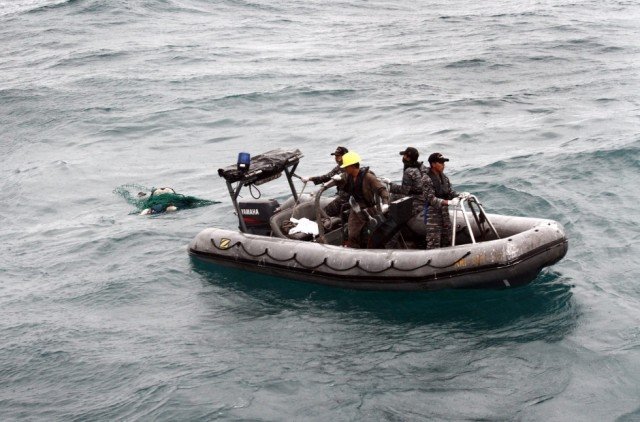
“These icy conditions can stall the engines of the plane and freeze and damage the planes machinery.”
Officials have said the plane was travelling at 32,000ft when the pilot’s last communication was a request to climb to 38,000ft to avoid bad weather.
Search chief Bambang Soelistyo said four large objects as well as oil slicks had been detected by sonar.
The biggest object is 59ft long and 18ft wide, he was quoted as saying by the Associated Press news agency, adding he believed the objects were parts of the plane. Another object is said to be 32ft long.
Bambang Soelistyo said an ROV (remotely operated underwater vehicle) was being lowered into the water to get an actual picture of the objects, which were at a depth of 98ft.
But he warned that waves up to 17ft high were hampering the search effort.
A flotilla of ships, including two from the US navy, are converging on the site where the objects were located and preparing to put divers into the water.
A Russian search team, including 22 deep water divers and a remotely operated submersible vessel, is expected to join the hunt for the black boxes after arriving in Pangkalan Bun on January 3.
It has emerged that AirAsia did not have official permission to fly the Surabaya-Singapore route on the day of the crash but was licensed on four other days of the week.
The Indonesian authorities suspended the company’s flights on this route pending an investigation. AirAsia said it would “fully co-operate”.
[youtube eASfVxJI48Y 650]
Two large objects have been found by search teams scouring the Java Sea for the wreckage of AirAsia flight QZ 8501, Indonesian officials say.
A remotely operated underwater vehicle was being lowered to take pictures, search and rescue agency chief Bambang Soelistyo said.
However, bad weather and heavy seas continue to hamper operations.
The jet disappeared with 162 people on board while flying from Surabaya in Indonesia to Singapore on December 28, 2014.
So far 30 bodies have been recovered in the search. No survivors have been found and the main sections of the Airbus A320 have not been retrieved.
Most bodies are thought to have been trapped in the plane’s fuselage.
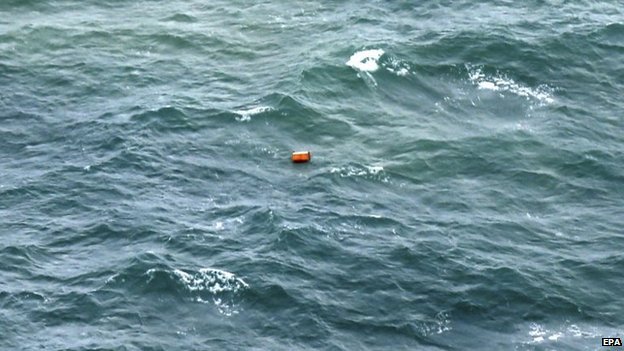
Photo EPA
Bambang Soelistyo said on January 3 that the large objects had been detected by sonar from an Indonesian navy ship.
“We found oil slicks and huge objects at 23:40 last night. I am confident these are parts of the missing AirAsia plane that we are looking for,” he said.
He said the larger of the objects was 32ft by 16ft but that strong currents made operating the underwater vehicle difficult.
A flotilla of ships, including two from the US navy, are converging on the site where the objects were located and preparing to put divers into the water.
The cause of the crash is not yet known. Specialist equipment has arrived to the search for the plane’s “black box” flight recorders, though officials say no signals have been picked up yet.
In another development, it has emerged that AirAsia did not have official permission to fly the Surabaya-Singapore route on December 28 – the day of the crash – but was licensed on four other days of the week.
The Indonesian authorities are suspending the company’s flights on this route with immediate effect pending an investigation, a transport ministry statement said.
Officials have said the plane was travelling at 32,000ft when it requested to climb to 38,000ft to avoid bad weather.
Some investigators are reported to believe that the plane may have gone into an aerodynamic stall as the pilot climbed steeply.
There were 137 adult passengers, 17 children and one infant, along with two pilots and five crew, on the plane – the majority Indonesian.
Four people have been identified so far: Hayati Lutfiah Hamid, Grayson Herbert Linaksita, Kevin Alexander Soetjipto and Khairunisa Haidar Fauzi.
[youtube NXCEZanrIJY 650]
AirAsia Flight QZ8501 bodies arrived back in the Indonesian city of Surabaya, where relatives are waiting.
Next of kin have been asked for DNA samples to help identify the victims.
The Airbus A320-200, carrying 162 people from Surabaya to Singapore, disappeared on December 28 and remains were located in the sea on December 30.
The authorities say seven bodies have been retrieved, but bad weather is hampering further salvage efforts.
A public memorial will be held in Surabaya on Wednesday evening local time.
All New Year’s Eve celebrations have been cancelled.
On board the plane were 137 adult passengers, 17 children and one infant, along with two pilots and five crew.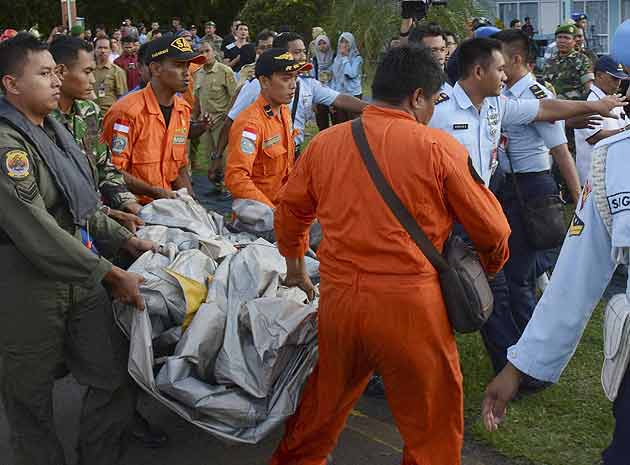
It is not yet clear what happened to the plane but its last communication was a request from air traffic control to climb to avoid bad weather. The pilot did not respond when given permission.
A three-day search ended on December 30 when remains including aircraft parts, luggage and the bodies were found in the Karimata Strait, south-west of the town of Pangkalan Bun in the Indonesian part of Borneo.
The bodies were flown to Surabaya’s Juanda airport on Wednesday afternoon from a hospital in Pangkalan Bun, where they had been sent from the crash site.
Another five bodies are reported to be on board a ship on their way to a harbor near Pangkalan Bun.
Four of the seven bodies are male and three female, one of them a flight attendant.
Strong winds and high waves have slowed down the recovery of bodies and debris, with helicopters mostly grounded and divers prevented from searching the waters.
The weather is forecast to deteriorate further, with heavy rains until January 2, 2015.
Next of kin of passengers and crew have been asked for DNA samples to help identify the bodies when they come in.
[youtube sm_TtkL9m_Q 650]
Rescue teams in the search for missing AirAsia Flight QZ8501 have recovered at least 40 bodies from the sea, the Indonesian navy says.
The bodies were spotted along with debris floating in the Java Sea off the Indonesian part of Borneo, in one of the search zones for the plane.
There has been no official confirmation that the remains come from the plane.
The Airbus A320-200, carrying 162 people from Surabaya in Indonesia to Singapore, disappeared on Sunday.
The search operation is now in its third day, with the area widened to cover 13 zones over land and sea.
In a separate development, there were reports of a second incident involving an AirAsia plane at Kalibo in the central Philippines. The reports said the plane overshot the runway.
During a news conference by the head of the search operation, shown live on Indonesian TV, pictures of the debris were shown including a body floating on the water.
Relatives of passengers on the plane watching the pictures were visibly shocked.
Later, the Indonesian navy reported that 40 bodies had been retrieved by one warship.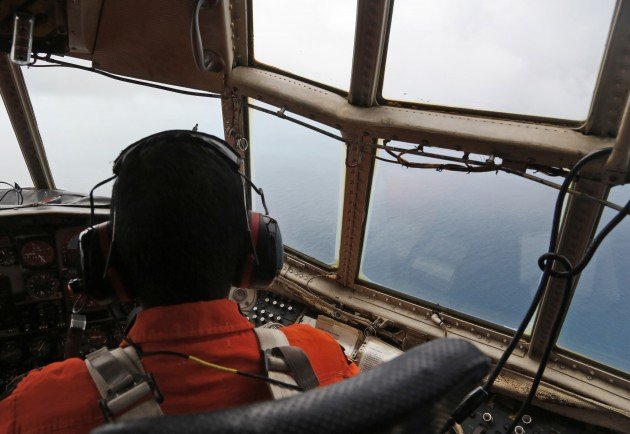
Its spokesman said the rescuers were continuing to recover bodies and were “very busy now”.
AirAsia CEO Tony Fernandes tweeted to the families: “My heart is filled with sadness for all the families involved in QZ 8501. On behalf of AirAsia, my condolences.”
Search operation head Bambang Soelistyo said he was 95% certain the objects shown were from the plane, adding that a shadow was spotted under water which appeared to be in the shape of a plane.
All resources were now being sent to the area where the debris was found, he said.
Bambang Soelistyo added that ships with more sophisticated technology were being deployed to check whether larger parts of the plane were submerged beneath the debris.
Indonesian civil aviation chief Djoko Murjatmodjo, quoted by AFP news agency, said “significant things” such as a passenger door and cargo door had been found.
Djoko Murjatmodjo added that the objects had been found 100 miles south-west of Pangkalan Bun in Borneo’s Central Kalimantan province.
At least 30 ships, 15 aircraft and seven helicopters joined the operation when it resumed at 06:00AM local time on December 30.
The operation, led by Indonesia, includes assistance from Malaysia, Singapore and Australia, with other offers of help from South Korea, Thailand, China and France. The US destroyer USS Sampson is on its way to the zone.
On board the plane were 137 adult passengers, 17 children and one infant, along with two pilots and five crew.
Most were Indonesian but the passengers included one UK national, a Malaysian, a Singaporean and three South Koreans.
AirAsia Flight QZ8501 left Surabaya at 05:35 Jakarta time on December 28 and had been due to arrive in Singapore two hours later.
Safety officials say the captain had asked for permission to take the plane higher but, by the time permission was granted, communication with the plane was lost.
The plane was officially declared missing at 07:55.
AirAsia previously had an excellent safety record and there were no fatal accidents involving its aircraft.
[youtube CuWbbGLVYpA 650]















